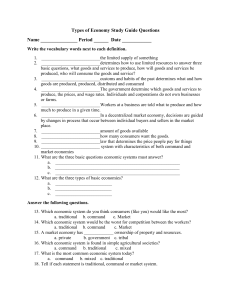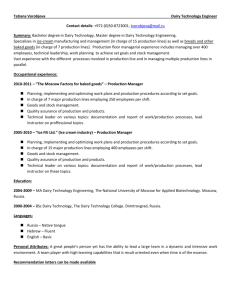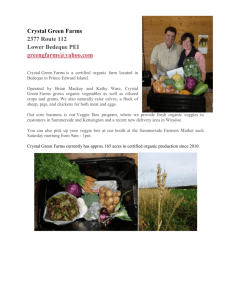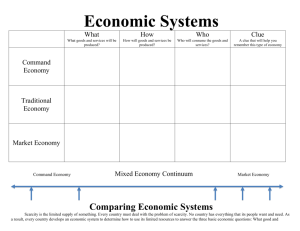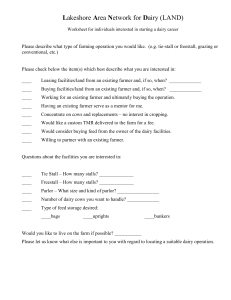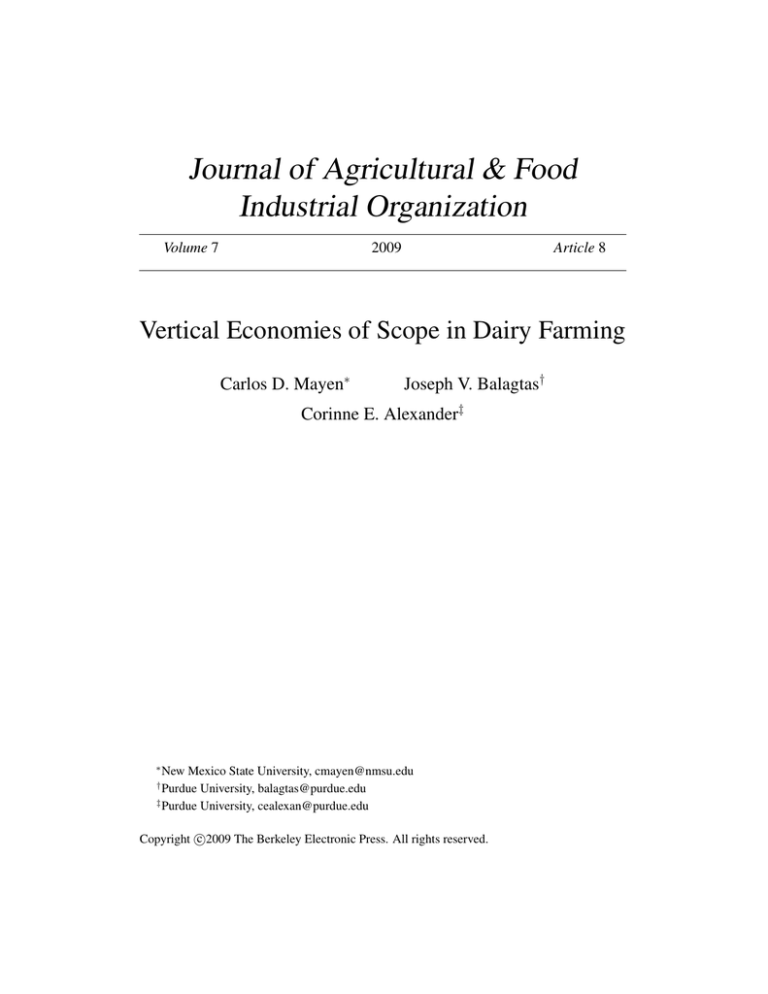
Journal of Agricultural & Food
Industrial Organization
Volume 7
2009
Article 8
Vertical Economies of Scope in Dairy Farming
Carlos D. Mayen∗
Joseph V. Balagtas†
Corinne E. Alexander‡
∗
New Mexico State University, cmayen@nmsu.edu
Purdue University, balagtas@purdue.edu
‡
Purdue University, cealexan@purdue.edu
†
c
Copyright 2009
The Berkeley Electronic Press. All rights reserved.
Vertical Economies of Scope in Dairy
Farming∗
Carlos D. Mayen, Joseph V. Balagtas, and Corinne E. Alexander
Abstract
With the exception of Azzam and Skinner (2007), the economic literature on farm structure
has largely neglected issues of vertical organization of the farm. In this article we estimate a
multi-stage, multi-output cost function in order to measure vertical economies of scope in organic
and conventional dairy farms. In particular, we model the integration of production of grains and
forages on dairy farms. We find negligible vertical economies of scope for conventional dairy
farms but significant vertical economies of scope in organic dairy production. The large vertical
economies of scope for organic dairy farms are consistent with higher costs of obtaining organic
feed through market transactions associated with an underdeveloped market for organic feeds.
KEYWORDS: vertical economies of scope, vertical integration, dairy
∗
This research has been supported by a Cooperative Agreement with USDA/ERS and by the Agricultural Experiment Station at Purdue University. The authors thank Ken Foster and Mike Schutz
for constructive comments on earlier versions of this research.
Mayen et al.: Vertical Economies of Scope in Dairy Farming
1
1. Introduction
Economies of scale and higher technical efficiency of larger dairy farms have put
smaller dairy farms at a cost disadvantage in the United States, thus contributing
to a shift in farm structure towards larger farms (Mosheim and Lovell 2009; Tauer
and Mishra 2006; MacDonald et al. 2007). From 1998 to 2007, the number of
U.S. dairy farms with fewer than 100 cows decreased by 44 percent, the number
of dairy farms with 100–499 cows decreased by 30 percent, and the number of
dairy farms with 500 cows or more increased by 39 percent. These changes in
farm structure have raised questions about the future of small dairy farms in the
United States (Tauer and Mishra 2006).
Small dairy farms have adopted management strategies to enhance
revenues and become more cost competitive with larger dairy farms. Some small
dairy farms have opted for product differentiation, targeting specialty, niche
markets such as organic dairy production. High price premiums for organic milk
make this market attractive for dairy farmers (McBride and Greene 2007). Yet the
presence of increasing returns to scale in organic dairy farming in the United
States may lead to an organic farm structure that follows the same trend towards
large farms observed in conventional milk production (Mayen, Balagtas, and
Alexander 2009). There is some indication that some small dairy farms have
adopted cost management strategies to offset economies of scale and be
competitive with larger dairy farms (Tauer and Mishra 2006; MacDonald et al.
2007). Although specific cost reduction strategies have not been identified, the
higher degree of vertical integration of small dairy farms may play an important
role (Sumner and Wolf 2002). This article extends the economic literature on
farm structure by modeling and measuring the potential for dairy farms to reduce
costs of production through vertical integration.
In multi-stage production processes a vertically integrated firm is involved
in two or more adjacent production stages, with the output from a first stage
transferred within the firm as an input for the subsequent stage. In contrast,
specialized firms acquire inputs and sell outputs through market transactions. If
the internal transfer of the intermediate product is less costly than the market
exchange, there exist vertical economies of scope (Perry 1989). Vertical
economies of scope may arise through technological economies, market
imperfections, or reduced transactions costs (Perry 1989; Kaserman and Mayo
1991). Technological economies exist when less of the intermediate products are
required to produce the same final product due to integration of the upstream
stage. Market failures, for example market power exercised in pricing of the
intermediate product, may result in higher costs of production for non-integrated
firms. Similarly, transactions costs associated with market exchanges may
increase costs for non-integrated firms.
Produced by The Berkeley Electronic Press, 2009
2
Journal of Agricultural & Food Industrial Organization
Vol. 7 [2009], Article 8
Although most agricultural production processes can be viewed as multistage production processes, and increasing vertical coordination is a stylized fact
in U.S. agriculture, the economic literature on U.S. farm structure is largely
absent of empirical estimates of vertical economies of scope. In a notable
exception Azzam and Skinner (2007) estimate vertical economies of scope in U.S.
hog production and find significant vertical economies of scope across different
combinations of farrow-to-feeder production and feeder-to-finish production. The
present article makes two key contributions to this literature. First, we provide
what are to our knowledge the first estimates of vertical economies of scope for
U.S. milk production. Second, we make a methodological contribution by
extending the framework adopted by Azzam and Skinner (2007) to include two
intermediate products and allow for heteroscedasticity.
We utilize a multi-stage, multi-output cost function framework to assess
vertical economies of scope on organic and conventional dairy farms. We model
the cost of jointly producing two first-stage products, grains and forages, which
are then used as inputs in milk production. We use the 2005 Agricultural
Resource Management Survey–Dairy Costs and Returns Report which provides
nationally representative data on production costs of organic and conventional
dairy farms in the United States.
2. Modeling Vertical Economies of Scope in Dairy Farming
Dairy farms may be diversified into a range of production enterprises, including
grain crops, forage crops, and pasture (Sumner and Wolf 2002). As well,
replacement heifers may be raised on the farm or sourced from specialized heifer
operations. Incentives to diversify into feed production may be particularly strong
because feed costs account for a large share of dairy operating expenses (Tozer
and Heinrichs 2001). Thus, in this study we focus on the potential for dairy farms
to reduce costs of production by integrating feed production.
Two methodologies have been used in the agricultural economic literature
to assess vertical economies of scope. Azzam (1998) used a difference in means
test to compare the actual costs of production of vertically-integrated hog farms to
the hypothetical costs of production if two separate, specialized farms produced
the same output. Azzam and Skinner (2007) used the same data but instead
utilized an econometric approach to assess vertical economies of scope. They
used a multi-stage cost function framework similar to the analyses of vertical
economies of scope in the electric industry (Kaserman and Mayo 1991; Kwoka
2002). They found this methodology more appropriate than the mean comparison
test because the cost function provides more economic information about the
http://www.bepress.com/jafio/vol7/iss1/art8
Mayen et al.: Vertical Economies of Scope in Dairy Farming
3
multi-stage technology in hog production. In contrast to the findings of Azzam
(1998), Azzam and Skinner (2007) found significant vertical economies of scope.
We adopt the multi-stage cost function framework to assess the degree of
vertical economies of scope in the dairy industry. We extend previous analyses of
vertical economies of scope which have analyzed the case of a single intermediate
product (Kaserman and Mayo 1991; Kwoka 2002; Azzam and Skinner 2007) by
including two intermediate products. For a firm which produces two intermediate
products and a single final product, vertical economies of scope exist if the cost of
jointly producing the intermediate products and the final product is lower than the
cost of producing the three products separately. Stated formally, vertical
economies of scope exist if the following inequality holds
(1)
C ( y1 , 0, 0) + C (0, y 2 , 0) + C (0, 0, y 3 ) > C ( y1 , y 2 , y 3 )
where C(.) is the cost function and y1 and y2 are intermediate products used as
inputs in the production of y3.
A scale-free measure of vertical economies of scope (VES) is
(2)
VES =
[C ( y1 , 0, 0) + C (0, y 2 , 0) + C (0, 0, y 3 ) − C ( y1 , y 2 , y 3 )]
.
C ( y1 , y 2 , y 3 )
This measure represents the percentage increase in costs of production on
specialized firms relative to costs on a vertically-integrated firm. Vertical
economies of scope exist if VES is greater than zero.
Kwoka (2002) and Azzam and Skinner (2007) estimate a multi-stage
quadratic cost function, which allows the inclusion of outputs with quantity of
production equal to zero. We extend the cost function to include two intermediate
products, grains (y1) and forages (y2), and a final product, milk (y3). (In the
following, we use subscript 1 to denote grains, subscript 2 to denote forages, and
subscript 3 to denote milk.)
We specify the cost function C(y1, y2, y3) as
C ( y1 , y 2 , y 3 ) = α 0 + β 1 D1 + β 2 D2 + β 3 D3 + α 1 y1 +
(3)
1
2
α 11 y12 + α 2 y 2 +
α 22 y 22 + α 3 y 3 + 1 2 α 33 y 32 + 1 2 α 12 y1 y 2 + 1 2 α 13 y1 y 3 +
1 α
2 23 y 2 y 3 + δ East d East + δ Cornbelt d Cornbelt + δ pasture d pasture
1
2
where Di, i ∈ (1,2,3), are dummy variables equal to one for a farm engaged in
enterprise i to allow for the enterprise-specific fixed costs of production; dEast and
dCornbelt are regional dummy variables (farms in the Upper Midwest are the
Produced by The Berkeley Electronic Press, 2009
Journal of Agricultural & Food Industrial Organization
4
Vol. 7 [2009], Article 8
benchmark group); and dpasture is a dummy variable equal to one for farms
obtaining more than 50 percent of their forage needs from pasture; and αs, βs, and
δs are parameters to be estimated. The cost function in (3) allows fixed costs that
are common across all three enterprises, α0, as well as enterprise-specific fixed
costs. As well, the interaction effects in (3) permit complementarity in variable
costs of jointly producing any pair of the three products. For example, the
marginal cost of producing milk,
(4)
∂C ( y1 , y 2 , y3 ) ∂y 3 = α 3 + α 33 y 3 +
1
2
α 13 y1 +
1
2
α 23 y 2 ,
may be decreasing (or increasing) in production of grains or forages.
Using equation (3), the scale-free measurement for vertical economies of
scope in equation (2) is
(5)
VES =
2α 0 −
1
2
α 12 y1 y 2 − 12 α 13 y1 y 3 − 12 α 23 y 2 y 3
C ( y1 , y 2 , y 3 )
.
Vertical economies of scope exist if the numerator is positive, i.e. if the sum of a
common fixed cost plus a scaled measure of cost complementarity is positive. The
common fixed cost α0 cannot be econometrically identified due to the nature of
our data. In particular, all farms in the data set are involved in milk production,
i.e. the dummy variable for milk production D3 in cost specification in equation
(3) is always equal to one. Since the common fixed cost α0 cannot be disentangled
from the estimated intercept coefficient, we follow Kwoka (2002) and assess the
complementarity effects of jointly producing grains, forages, and milk. Thus, we
estimate a scale-free measure of vertical economies of scope due to cost
complementarities as
(6)
VES C =
−
1
2
α 12 y1 y 2 − 12 α 13 y1 y 3 − 12 α 23 y 2 y 3
C ( y1 , y 2 , y 3 )
.
Because we drop the shared fixed costs, which are by definition non-negative, we
interpret VESC as a lower bound of vertical economies of scope. Actual vertical
scope economies are larger than indicated by VESC if shared fixed costs are
strictly positive.
In addition to equation (6), we also estimate an upper bound of vertical
economies of scope VESCU by adding the estimate of the constant term, which
accounts for the common fixed cost plus the fixed cost specific to the dairy
enterprise (α0 + β3), to the numerator of equation (6). Inclusion of α0 + β3 in the
VSE measure is appropriate if the milk-specific fixed cost of production is zero,
http://www.bepress.com/jafio/vol7/iss1/art8
Mayen et al.: Vertical Economies of Scope in Dairy Farming
5
so that the intercept measures only the common fixed cost. To the extent that
milk-specific fixed costs are non-zero, VESCU overstates the vertical economies of
scope.
Appending an error term to the cost function in (3) yields our econometric
cost specification
C ( y1 , y 2 , y 3 ) = α 0 + β 1 D1 + β 2 D2 + α 1 y1 +
1
2
α 11 y12 + α 2 y 2 +
α 22 y 22 + α 3 y 3 + 1 2 α 33 y 32 + 1 2 α 12 y1 y 2 + 1 2 α 13 y1 y 3 +
1 α y y +δ
2 23 2 3
East d East + δ Cornbelt d Cornbelt + δ pasture d pasture + ε .
(7)
1
2
where the disturbance terms ε are independently and normally distributed with
zero means and variance σ2. We test for and model heteroscedasticity by positing
Harvey’s model of multiplicative heteroscedasticity (Harvey 1976), which
specifies variance as
(8)
σ 2 = exp( z ' γ ),
where z is the a vector of variables suspected to affect the variance and γ is a
vector of parameters to be estimated. We include a constant and the natural
logarithm of herd size in z.
3. Data
We use data on U.S. dairy farms from the 2005 Agricultural Resource
Management Survey (ARMS) Dairy Costs and Returns Report. ARMS is a multiframe, probability-based survey in which farms are randomly selected from
groups of dairy farms stratified by value of sales. Each sampled farm represents a
number of farms that are of similar value of sales; this number represents the
survey expansion factor, or weight. Weighting is recommended for descriptive
and econometric analyses when inferences are made of the population of interest
(Dubman 2000). In this study we use the ARMS farm weights to weigh the means
analysis and the maximum likelihood function when estimating the multiplicative
heteroscedastic cost functions. Since ignoring stratification in the estimation of
variances is not likely to cause substantial biases, we use the traditional variance
estimators to test for statistical significance in the mean comparison tests and
econometric models (Carrington et al. 2000).1 Traditional variance estimators
1
There are two alternative procedures for estimating variances when using ARMS data: the
delete-a-group jackknife variance estimator proposed by Dubman (2000) and the probability-
Produced by The Berkeley Electronic Press, 2009
6
Journal of Agricultural & Food Industrial Organization
Vol. 7 [2009], Article 8
have been used by other researchers when estimating econometric models using
ARMS data (Fernandez-Cornejo, Hendricks, and Mishra 2005).
We restrict this analysis to farms in the traditional dairy regions of the
United States: Cornbelt region (Illinois, Indiana, Iowa, Missouri, Ohio), East
region (Maine, New York, Pennsylvania, Vermont), and the Upper Midwest
region (Michigan, Minnesota, Wisconsin). These regions have a higher degree of
vertical integration than farms in the west and southeast (Sumner and Wolf 2002).
The usable sample with complete observations for all variables used in this
analysis consists of 205 organic dairy farms and 527 conventional dairy farms.
After we apply the respective weights, the weighted sample represents
approximately 505 organic dairy farms and 29,461 conventional dairy farms in
the United States.
Although the primary revenue source for farms in our sample is milk, they
also may receive revenue from cattle sales, cooperative dividends, and manure
sales. The costs associated with the secondary revenue-generating items cannot be
separated from the cost of producing milk. Thus to more accurately take into
account the added cost due to higher secondary revenues, we utilize a production
equivalent which consists of hundredweight (100 pounds) of milk necessary to
provide the same level of income from milk sales and secondary revenue (Frank
1998). That is, secondary revenue is divided by the per hundredweight price of
milk, and is then added to farm milk production.
Dairy farms use different types of feed inputs in milk production. We
aggregate grains and forages produced on the farm based on total digestible
nutrients (TDN). TDN is directly related to the feed’s nutrient content, as reported
in the Directory of Feeds and Feed Ingredients (McGregor 1989). For quantity of
grains we include corn, barley, sorghum, wheat, soybeans, and oats. For quantity
of forages we include alfalfa hay, all other hay, corn silage, and sorghum silage.
We approximate TDN of grazed forage by assuming that the maximum voluntary
intake of forage by cows is 2.5 pounds of dry matter per day per hundredweight of
body weight (Foley et al. 1972). We do not have complete information on the
quality and type of grazed pasture thus we assume that grazed forages consist of
50 percent of TDN. To obtain the annual consumption of grazed forage we utilize
weighted bootstrapping technique as proposed by Goodwin and Mishra (2004). A disadvantage of
the former procedure is that the when using a subset of the overall sample, the jackknife approach
may not be valid since the replicate weights provided with the ARMS data set would be distorted
when certain data observations are not included (Goodwin, Mishra, and Ortalo-Magne 2003). A
disadvantage of the latter is that the weights on organic dairy farms are so small that the likelihood
of selecting organic farms to conform to the pseudo-sample is very small. Without organic farms
being selected, the comparison between organic and conventional dairy farms would be
impossible.
http://www.bepress.com/jafio/vol7/iss1/art8
Mayen et al.: Vertical Economies of Scope in Dairy Farming
7
the survey data on the reported months of the year that the cows are grazing, and
the percent of forage needs that are obtained from pasturing.
The cost of producing grains, forages, and milk includes accounting and
economic costs. The accounting costs include expenditures on seeds, fertilizer,
agricultural chemicals, livestock, leasing of livestock, purchased feed, purchased
bedding and litter, medical supplies, fuels and oils, electricity, other utilities, farm
supplies, repairs and maintenance, renting of land for raising crops and grazing,
total cash wages paid for hired labor, contract labor, custom work, non-real estate
property taxes and insurance, and other general business expenses. The economic
costs include operating interest, opportunity cost of capital, and opportunity cost
of labor by the operator and family members. Operating interest is calculated as
the variable cost of production times the interest rate of a 6 month Treasury bill in
2005 (3.4 percent). The cost of capital includes the depreciation and interest paid
on farm assets (machinery, buildings, and livestock), the opportunity cost of land
owned by the farm which is used to raise crops and house the dairy facility, and
the opportunity cost of money spent on capital assets. The opportunity cost of
owned land is equivalent to average state rental rates for acres of land used to
raise crops and for grazing. The opportunity cost of capital assets is equal to a
charge of 3.4 percent on the 2005 market value of farm assets which includes the
inventory of inputs and crops, breeding livestock, farm machinery, and buildings.
For the opportunity cost of labor, we obtain the amount of time worked by the
operator and family members on the farm directly from the survey. The wage rate
for the operator is estimated by ERS’s cost of production estimates which utilize
the opportunity cost of farm operator labor employed off-farm, estimated from an
econometric model of off-farm labor supply and wages (El-Osta and Ahearn
1996). For family labor, we utilize average state hourly rates for farm work and
minimum wage rates for employees less than 16 years of age.
When assessing vertical economies of scope all costs need to be net of
expenditures on purchases of the intermediate products to avoid double counting
(Kwoka 2002; Azzam and Skinner 2007). In our case, all costs are net of
expenditures on purchased grains and forages. For a vertically-integrated farm
there are no expenditures to be deducted, whereas for a farm which specializes in
milk production the entire expenses on feed purchases are deducted from the cost
of production. With this correction to the costs of production we implicitly correct
for any potential pricing above marginal cost of the intermediate product. This
adjustment in the cost allows the comparison of cost differences between making
and purchasing feed.
In table 1 we report means, standard errors, and statistical significance of
the mean comparison tests between organic and conventional farms for the
variables included in this study. A striking difference between organic and
conventional dairy farms is farm size as measured by number of milking cows.
Produced by The Berkeley Electronic Press, 2009
Journal of Agricultural & Food Industrial Organization
8
Vol. 7 [2009], Article 8
Average herd size on organic dairy farms is approximately 64 cows, whereas the
average herd size on conventional dairy farm is 103 cows. On organic farms,
Table 1. Mean Comparisons of Production and Farm Characteristics for
Organic and Conventional Dairy Farms
Organic Production
Conventional Production
(N = 205)
(N = 527)
Mean
S.E.
Mean
S.E.
Milking Cows
63.6
2.4
102.9
7.30***
Grains (1,000 cwt)
1.55
0.18
5.50
0.44***
Forages (1,000 cwt)
4.97
0.34
8.21
0.55***
Milk (1,000 cwt)
8.98
0.39
22.19
1.84***
Grain Production (1/0)
0.56
0.03
0.70
0.02***
Forage Production (1/0)
0.98
0.01
0.98
0.01
Upper Midwest (1/0)
0.50
0.04
0.48
0.02
Cornbelt (1/0)
0.09
0.02
0.17
0.02**
East (1/0)
0.41
0.03
0.35
0.02
Pasture (1/0)
0.59
0.03
0.14
0.02***
Note: For each variable we tested the hypothesis that organic and conventional means were equal.
Asterisks denote statistical significance of the test statistic at the 10 percent (*), 5 percent (**), and
1 percent (***) levels.
average annual grain production is approximately 1,550 cwt of TDN from grains,
average annual forage production is 4,970 cwt of TDN from forages, and average
annual milk production is 8,980 cwt. On conventional farms, average grain
production is approximately 5,500 cwt of TDN, average forage production is
8,210 cwt of TDN, and average milk production is 22,190 cwt. Grain production
http://www.bepress.com/jafio/vol7/iss1/art8
Mayen et al.: Vertical Economies of Scope in Dairy Farming
9
occurs in 56 percent of organic dairies and 70 percent of conventional dairies.
Forage production occurs in 98 percent of organic and conventional dairy farms.
The sample contains more organic and conventional dairy farms in the Upper
Midwest, than in the East, followed by the Cornbelt region. Approximately 59
percent of organic dairy farms obtain more than 50 percent of their forage needs
from pasture, whereas only 14 percent of conventional dairy farms do.
4. Estimation, Results, and Discussion
We use a likelihood ratio test to reject the hypothesis of homoscedasticity, i.e. γ
= 0, for the organic production cost model (p-value < 0.01) and the conventional
production cost model (p-value < 0.01). For both cost models we find that herd
size has a statistically significant, positive effect on the variance.
We present the estimated cost functions for organic production and
conventional production in table 2. Both models have explanatory power with
statistically significant effects for certain variables. For the organic production
model we find a statistically significant, positive fixed cost specific to forage
production and a statistically insignificant fixed cost specific to grain production.
The imprecise estimate of the fixed cost specific to organic grain production stage
may be due to the lack of data needed to estimate the cost of production at the
origin. We also find statistically significant positive linear effects of grains,
forages, and milk on the cost of organic production. The marginal costs for grain
production, forage production, and milk production are positive and constant with
respect to their own output. The only statistically significant interaction term is
for the joint production of organic forages and milk. The negative sign of this
interaction points to cost complementarities. The marginal cost of milk is
decreasing in forage output and the marginal cost of forage is decreasing in milk
output.
For the conventional production model, we find a statistically significant
linear effect of forages on the cost of conventional production. The marginal cost
for forage production is positive and constant with forage output. We find
statistically significant linear and quadratic effects of grains and milk on cost of
production. Of particular relevance to our analysis of vertical scope economies,
we find statistically significant cost complementarities for the joint production of
grains and forages, i.e. the marginal cost of grain is decreasing in forage output
Produced by The Berkeley Electronic Press, 2009
Journal of Agricultural & Food Industrial Organization
10
Vol. 7 [2009], Article 8
Table 2. Estimated Cost Functions for Organic and Conventional Dairy
Production
Organic Production
Cost Model
Coefficient
S.E.
Conventional Production
Coefficient
S.E.
Constant
13.114
26.246
56.662
Grain Productiona
–7.159
8.275
–3.417
6.115
Forage Productionb
43.904
25.855*
3.170
20.067
8.847
4.648*
7.434
–0.880
1.943
–0.068
Grains c
Grains × Grains
Forages c
7.851
3.203**
8.874
20.047***
0.830***
0.037*
0.992***
Forages × Forages
–0.063
0.280
–0.039
0.056
Grains × Forages
0.167
1.023
–0.273
0.119**
3.211***
9.646
0.402***
Milk c
15.851
Milk × Milk
0.658
0.483
0.006
0.003**
Milk × Grains
0.116
1.206
0.098
0.047**
Milk × Forages
–1.244
0.582**
East
–9.467
Cornbelt
Pasture
–0.022
0.025
7.197
1.472
6.159
3.438
14.339
–9.706
6.363
–6.510
6.496
–0.001
6.247
Heteroscedasticity Model
Constant
Logarithm Herd
Size
0.212
0.585**
1.549
0.875***
1.777
0.225***
1.095
0.058***
Note: Asterisks denote statistical significance at the 10 percent (*), 5 percent (**), and 1 percent
(***) levels. a Grain production is a dummy variable equal to 1 when any grains are produced on
the farm. b Forage production is a dummy variable equal to 1 when any forage is produced on the
farm. c Quantities of grains, forages, and milk are in 1,000 cwt.
http://www.bepress.com/jafio/vol7/iss1/art8
Mayen et al.: Vertical Economies of Scope in Dairy Farming
11
and the marginal cost of forage is decreasing in grain output. However, the
interaction effect for grains and milk is statistically significantly positive. This
means that the marginal cost of grain is increasing in milk output and the marginal
cost of milk is increasing in grain output.
In table 3 we present estimates of VESC and VESCU for three herd-size
categories (small, average, and large) of organic and conventional dairy farms.
We define “small” dairy farms as those with 100 cows or less, and farms with
more than 100 cows to be large farms. This classification is based on ERS’s farm
typology, in which a farm with annual sales less than $250,000 is defined as a
small family farm. Given this definition, and with additional assumptions on yield
Table 3. Vertical Economies of Scope for Organic and Conventional Dairy
Farms by Herd Size
Farm Type and Herd Size
Mean Input Use
VESCc
VESCUd
Grainsa
Foragesa
Milkb
55 cows
1.30
4.10
7.77
0.174
0.294
64 cows
1.55
4.97
8.98
0.217
0.326
143 cows
3.79
12.70
19.69
0.679
0.740
55 cows
2.91
4.88
10.74
0.009
0.519
103 cows
5.50
8.21
22.19
0.011
0.311
230 cows
12.32
17.00
52.34
0.017
0.161
Organic Farms
Conventional Farms
a
Quantities of grains and forages are in 1,000 cwt of TDN per year. b Quantity of milk is in 1,000
cwt per year. c VESC represents the percentage increase in costs of production on specialized farms
relative to costs on a vertically-integrated farm estimated using equation 6. d VESCU represents the
upper limit of the percentage increase in costs of production on specialized farms relative to costs
on a vertically-integrated farm estimated using equation 5 plus the estimate of the intercept term
which accounts for α0 + β3.
Produced by The Berkeley Electronic Press, 2009
Journal of Agricultural & Food Industrial Organization
12
Vol. 7 [2009], Article 8
and milk price, small organic and conventional dairy farms would consist of
approximately 100 milking cows or less. Mean herd size for the average and large
categories for conventional dairy farms are larger than for organic dairy farms.
For each type of farm and size category, we evaluate VESC and VESCU at the mean
production levels for grains, forages, and milk.
The estimates of vertical economies of scope differ dramatically between
organic and conventional dairy farms. For organic farms, we find significant
VESC for all sizes. For the organic dairy farm with an average-sized herd
(approximately 64 milking cows) the total economic costs of verticallydisintegrated production for grains, forages, and milk would be approximately 22
percent higher than for vertically-integrated production. Cost increases due to
vertically-disintegrated production would be approximately 17 percent for an
organic farm with 55 cows and 68 percent higher an organic farm with 143 cows.
As expected, a strictly positive common fixed cost of production results in a
higher estimate for VESCU. Thus organic dairy farms appear to have a strong
economic incentive to integrate into feed production.
In contrast, we find negligible vertical economies of scope (i.e., VESC
values close to zero) for conventional dairy farms of all sizes. Integrated
production of feed and forage does not lower costs on dairy farms relative to milk
production with feed acquired through market transactions. The estimates of
VESCU are significantly higher than vertical economies of scope due to cost
complementarities, VESC , indicating that a strictly positive common fixed cost of
production may result in significant vertical economies of scope.
5. Conclusion
Economic analysis of structural change in U.S. animal agriculture has focused
almost extensively on consolidation and the associated economies of scale (e.g.,
MacDonald et al. 2007; MacDonald and McBride 2009). The vertical dimension
of farm structure has been largely neglected from economic studies of the
structure of livestock production. Aside from descriptive studies of vertical
integration in the different livestock industries in the United States (Ward 1997;
Sumner and Wolf 2002), only Azzam (1998) and Azzam and Skinner (2007) have
attempted to estimate economies of vertical integration in the livestock
production. To our knowledge, this article is the first empirical analysis of the
vertical dimension of farm structure in the U.S. dairy industry. We assess
economies associated with of integration of feed and milk production in the
traditional dairy regions of the United States, using data from the 2005 ARMS
Dairy Costs and Returns Report. We use a multi-stage, multi-output cost function
framework to assess vertical economies of scope in organic and conventional
http://www.bepress.com/jafio/vol7/iss1/art8
Mayen et al.: Vertical Economies of Scope in Dairy Farming
13
dairy farms. We model the cost of jointly producing two products, grains and
forages, which are used as inputs in milk production. We focus on economies
from integrating feed production because feed represents the highest production
expense in dairy farming (MacDonald et al. 2007).
We find negligible vertical economies of scope in conventional production
due to cost complementarities. But significant vertical economies of scope may
exist if the common shared cost of producing all three outputs is sufficiently large.
Other non-pecuniary drivers for the higher degree of vertical integration in small,
conventional dairy farms may also exist (Sumner and Wolf 2002). In contrast, we
find significant vertical economies of scope due to cost complementarities in
organic dairy production. The relative cost savings of vertical integration on
organic dairy farms increase with herd size. An average-sized organic dairy farm
may reduce the cost of production by 22 percent by vertically integrating into
grain and forage production, providing organic dairy farms with a strong
economic incentive to integrate into feed production. The large vertical
economies of scope for organic dairy farms are consistent with higher costs of
obtaining organic feed through market transactions associated with an
underdeveloped market for organic feeds (Benson 2008).
References
Azzam, A. 1998. “Testing for Vertical Economies of Scope: An Example from
Hog Production.” Journal of Agricultural Economics 49: 427–533.
Azzam, A., and C.S. Skinner. 2007. “Vertical Economies and Structure of U.S.
Hog Farms.” Canadian Journal of Agricultural Economics 55:349–364.
Benson, A.F. 2008. “Organic Dairy Updates.” Available at http://www.organic.
cornell.edu/organicdairy/News.html (accessed on April 15, 2009).
Carrington, W.G., J.L. Eltinge, and K. McCue. 2000. An Economist’s Primer on
Survey Samples. Center for Economic Studies, U.S. Bureau of the Census
CES 00-15, October.
Dubman, R.W. 2000. Variance Estimation with USDA’s Farm Costs and Returns
Surveys and Agricultural Resource Management Study Surveys.
Washington, DC: U.S. Department of Agriculture, Economic Research
Service. ERS Staff Paper AGES 00–01. April.
El-Osta, H.S. and M.C. Ahearn. 1996. Estimating the Opportunity Costs of
Unpaid Labor for U.S. Farm Operators. Washington, DC: U.S.
Department of Agriculture, Economic Research Service. Technical
Bulletin No. 1848, March.
Produced by The Berkeley Electronic Press, 2009
14
Journal of Agricultural & Food Industrial Organization
Vol. 7 [2009], Article 8
Fernandez-Cornejo, J., C. Hendricks, and A. Mishra. 2005. “Technology
Adoption and Off-Farm Household Income: The Case of HerbicideTolerant Soybeans.” Journal of Agricultural and Applied Economics 37:
549-563.
Foley, R.C., D.L. Bath, F.N. Dickinson, and H.A. Tucker. 1972. Dairy Cattle:
Principles, Practices, Problems, Profits. Philadelphia: Lea and Febiger.
Frank, G. “Cost of Production versus Cost of Production.” University of
Wisconsin. Center for Dairy Profitability. August 1998.
Goodwin, B.K., and A.K. Mishra. 2004. “Farming Efficiency and the
Determinants of Multiple Job Holding by Farm Operators.” American
Journal of Agricultural Economics 86: 722-729.
Goodwin, B.K., A.K. Mishra, and F.N. Ortalo-Magné. 2003. “What’s Wrong
With Our Models of Agricultural Land Values?” American Journal of
Agricultural Economics 85: 744-752.
Harvey, A.C. 1976. “Estimating Regression Models with Multiplicative
Heteroscedasticity.” Econometrica 44: 461–465.
Kaserman, D.L., and J.W. Mayo. 1991. “The Measurement of Vertical Economies
and the Efficient Structure of the Electric Utility Industry.” Journal of
Industrial Economics 39: 483–502.
Kwoka, J.E. 2002. “Vertical Economies in Electric Power: Evidence on
Integration and its Alternatives.” International Journal of Industrial
Organization 20:653–671.
MacDonald, J.M., E.J. O’Donoghue, W.D. McBride, R.F. Nehring,
C.L.Sandretto, and R. Mosheim. 2007. Profits, Costs, and the Changing
Structure of Dairy Farming. Washington, DC: U.S. Department of
Agriculture, Economic Research Service. Economic Research Report No.
47, September.
Macdonald, J.M. and W.D. McBride. 2009. The Transformation of U.S.
Livestock Agriculture. Washington, DC: U.S. Department of Agriculture,
Economic Research Service. Economic Information Bulletin No. 43,
January.
Mayen, C., J. Balagtas, and C. Alexander. Forthcoming. “Technology Adoption
and Technical Efficiency: Organic and Conventional Dairy Farms in the
United States.” American Journal of Agricultural Economics.
McBride, W.D., and C. Greene. 2007. “A Comparison of Conventional and
Organic Milk Production Systems in the U.S.” Selected Paper presented at
AAEA annual meeting, Portland, OR, 29–31 July.
McGregor, C.A. 1989. Directory of Feeds and Feed Ingredients. Wisconsin:
W.D. Hoard and Sons Co.
Mosheim, R., and C.A. Knox Lovell. 2009. “Scale Economies and Inefficiency of
U.S. Dairy Farms.” American Journal of Agricultural Economics 91:777–
794.
http://www.bepress.com/jafio/vol7/iss1/art8
Mayen et al.: Vertical Economies of Scope in Dairy Farming
15
Perry, M.K. 1989. “Vertical Integration: Determinants and Effects.” In
Schmanelsee, R. and Willig, R. (eds.). Handbook of Industrial
Organization. New York, NY: North Holland.
Sumner, D.A., and C.A. Wolf. 2002. “Diversification, Vertical Integration, and
Regional Pattern of Dairy Farm Size.” Review of Agricultural Economics
24:442–457.
Tauer, L.W., and A.K. Mishra. 2006. “Can the Small Dairy Farm Remain
Competitive in US Agriculture?” Food Policy 31:458–468.
Tozer, P.R. and A.J. Heinrichs. 2001. “What Affects the Costs of Raising
Replacement Heifers: A Multiple-Component Analysis.” Journal of Dairy
Science 84: 1836–1844.
Ward, C.E. 1997. “Vertical Integration Comparison: Beef, Pork, and Poultry.”
Paper presented at WAEA annual meeting, Reno, NV, 13–16 July.
Produced by The Berkeley Electronic Press, 2009


